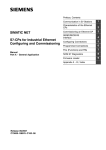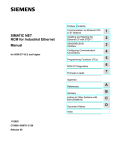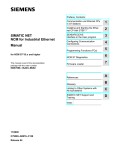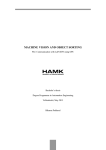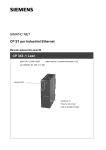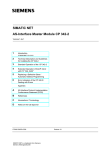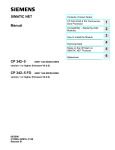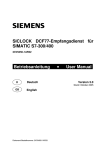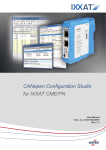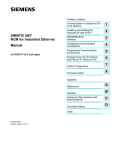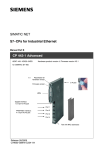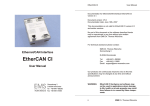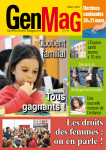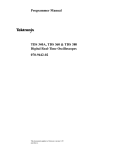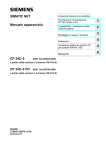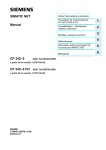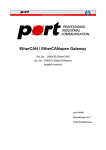Download EtherCAN-S7-Manual (PDF-File)
Transcript
EtherCAN-S7 EtherCAN/2-S7 Industrial Ethernet / UDP Gateway Software Manual to Product C.2050.07, C.2051.07 EtherCAN-S7 Software Manual • Doc. No.: C.2050.28 / Rev. 1.2 esd electronic system design gmbh Vahrenwalder Str. 207 • 30165 Hannover • Germany www.esd.eu • Fax: 0511/37 29 8-68 Phone: 0511/37 29 80 • International: +49-5 11-37 29 80 Page 1 of 48 NOTE The information in this document has been carefully checked and is believed to be entirely reliable. esd makes no warranty of any kind with regard to the material in this document, and assumes no responsibility for any errors that may appear in this document. esd reserves the right to make changes without notice to this, or any of its products, to improve reliability, performance or design. esd assumes no responsibility for the use of any circuitry other than circuitry which is part of a product of esd gmbh. esd does not convey to the purchaser of the product described herein any license under the patent rights of esd gmbh nor the rights of others. esd electronic system design gmbh Vahrenwalder Str. 207 30165 Hannover Germany Phone: Fax: E-mail: Internet: +49-511-372 98-0 +49-511-372 98-68 [email protected] www.esd.eu USA / Canada: esd electronics Inc. 525 Bernardston Road Suite 1 Greenfield, MA 01301 USA Phone: Fax: E-mail: Internet: Page 2 of 48 +1-800-732-8006 +1-800-732-8093 [email protected] www.esd-electronics.us Software Manual • Doc. No.: C.2050.28 / Rev. 1.2 EtherCAN-S7 Document file: I:\Texte\Doku\MANUALS\CAN\EtherCAN\Englisch\EtherCAN-S7\EtherCAN_to-S7_Software_en_12.wpd Date of print: 2009-09-21 Software version: EtherCAN 0.1 Changes in the chapters The changes in the user’s manual listed below affect changes in the software as well as changes in the description of the facts only. Chapter Changes versus previous version - First version - - Technical details are subject to change without notice. EtherCAN-S7 Software Manual • Doc. No.: C.2050.28 / Rev. 1.2 Page 3 of 48 This page has been left blank intentionally. Page 4 of 48 Software Manual • Doc. No.: C.2050.28 / Rev. 1.2 EtherCAN-S7 Contents 1. Introduction . . . . . . . . . . . . . . . . . . . . . . . . . . . . . . . . . . . . . . . . . . . . . . . . . . . . . . . . . . . . . . . . . 7 2. Configuration Procedure . . . . . . . . . . . . . . . . . . . . . . . . . . . . . . . . . . . . . . . . . . . . . . . . . . . . . . . 8 2.1 Configure CP-Hardware . . . . . . . . . . . . . . . . . . . . . . . . . . . . . . . . . . . . . . . . . . . . . . . . . . . . . 8 2.2 Configuration of Network with NetPro . . . . . . . . . . . . . . . . . . . . . . . . . . . . . . . . . . . . . . . . . 10 2.2.1 Accessing NetPro Program . . . . . . . . . . . . . . . . . . . . . . . . . . . . . . . . . . . . . . . . . . . . 10 2.2.2 NetPro Program Window . . . . . . . . . . . . . . . . . . . . . . . . . . . . . . . . . . . . . . . . . . . . . 11 2.2.3 Adding a Station . . . . . . . . . . . . . . . . . . . . . . . . . . . . . . . . . . . . . . . . . . . . . . . . . . . . 12 2.2.4 Configuration Other Station . . . . . . . . . . . . . . . . . . . . . . . . . . . . . . . . . . . . . . . . . . . 12 2.3 Configuring the Connection . . . . . . . . . . . . . . . . . . . . . . . . . . . . . . . . . . . . . . . . . . . . . . . . . 14 2.4 Copying Components from Included Project . . . . . . . . . . . . . . . . . . . . . . . . . . . . . . . . . . . . 16 3. CAN . . . . . . . . . . . . . . . . . . . . . . . . . . . . . . . . . . . . . . . . . . . . . . . . . . . . . . . . . . . . . . . . . . . . . . . 17 3.1 Basics of CAN Communication . . . . . . . . . . . . . . . . . . . . . . . . . . . . . . . . . . . . . . . . . . . . . . 17 3.2 CAN Errors and CAN Error Localization . . . . . . . . . . . . . . . . . . . . . . . . . . . . . . . . . . . . . . . 31 4. Functional Characteristics . . . . . . . . . . . . . . . . . . . . . . . . . . . . . . . . . . . . . . . . . . . . . . . . . . . . 4.1 Function Block FB77 . . . . . . . . . . . . . . . . . . . . . . . . . . . . . . . . . . . . . . . . . . . . . . . . . . . . . . . 4.1.1 Parameters CONN_ID and MOD_ADDR . . . . . . . . . . . . . . . . . . . . . . . . . . . . . . . . 4.1.2 Configuring the CAN Bit Rate with BAUD . . . . . . . . . . . . . . . . . . . . . . . . . . . . . . . 4.2 Data Type UDT1 . . . . . . . . . . . . . . . . . . . . . . . . . . . . . . . . . . . . . . . . . . . . . . . . . . . . . . . . . . 4.2.1 UDT1 with CAN Messages (CMSG) . . . . . . . . . . . . . . . . . . . . . . . . . . . . . . . . . . . . 4.2.2 UDT1 in CAN Events (EVMSG) . . . . . . . . . . . . . . . . . . . . . . . . . . . . . . . . . . . . . . . 4.3 Data Module DB1 . . . . . . . . . . . . . . . . . . . . . . . . . . . . . . . . . . . . . . . . . . . . . . . . . . . . . . . . . 4.4 Data Block DB2 . . . . . . . . . . . . . . . . . . . . . . . . . . . . . . . . . . . . . . . . . . . . . . . . . . . . . . . . . . . 4.4.1 CanIdRange . . . . . . . . . . . . . . . . . . . . . . . . . . . . . . . . . . . . . . . . . . . . . . . . . . . . . . . . 32 32 34 35 37 37 40 43 44 44 5. Monitoring Ethernet Communication via Heartbeat . . . . . . . . . . . . . . . . . . . . . . . . . . . . . . . 45 6. Appendix . . . . . . . . . . . . . . . . . . . . . . . . . . . . . . . . . . . . . . . . . . . . . . . . . . . . . . . . . . . . . . . . . . . 46 6.1 Bit-Timing Values (Examples) . . . . . . . . . . . . . . . . . . . . . . . . . . . . . . . . . . . . . . . . . . . . . . . 46 6.2 S7-Returned Values . . . . . . . . . . . . . . . . . . . . . . . . . . . . . . . . . . . . . . . . . . . . . . . . . . . . . . . . 47 EtherCAN-S7 Software Manual • Doc. No.: C.2050.28 / Rev. 1.2 Page 5 of 48 This page has been left blank intentionally. Page 6 of 48 Software Manual • Doc. No.: C.2050.28 / Rev. 1.2 EtherCAN-S7 Introduction 1. Introduction This manual describes the functionality of EtherCAN-S7 (C.2050.07) and the EtherCAN/2-S7 (C.2051.07). In this manual both modules are described together as EtherCAN-S7. EtherCAN-S7 connects the Siemens-PLC S7 with the CAN bus via a FB77 function block. PC with SIMATIC Manager and NetPro S7 with FB77Function Block Configuration ELLSI Control Ethernet Data ELLSIInterface EtherCAN-S7 CAN-Interface Control CAN Bus Data CAN Fig. 1: Connection of Siemens-PLC S7 to a CAN bus via EtherCAN-S7 By means of function block FB77 and EtherCAN-S7 a Siemens-PLC-S7 with industrial Ethernet interface can transmit and receive CAN telegrams and monitor the status of the connected CAN bus. The network is configured via the Siemens tool NetPro. EtherCAN-S7 communicates with Siemens-PLC S7 via ELLSI protocol by esd. Please refer to the ELLSI software manual for further information about ELLSI. This application does not require knowledge on ELLSI, however. EtherCAN-S7 Software Manual • Doc. No.: C.2050.28 / Rev. 1.2 Page 7 of 48 Configuration 2. Configuration Procedure First start the SIMATIC manager and create a new project. Insert a new station and start the hardware manager. Insert a CP. If your PLC already supports Industrial Ethernet, configure it accordingly (please refer to the manual of your PLC). Double-clicking CP opens the properties window for CP hardware configuration. 2.1 Configure CP-Hardware - Properties of CP: In order to configure the properties of Ethernet-S7 click on the Properties button. The window shown in fig. 3 will open. Fig. 2: CP properties In the window Properties-Ethernet interface you can now configure the IP address of the CP and the subnetwork mask. Confirm your entries with OK. Fig. 3: Parameters Page 8 of 48 Software Manual • Doc. No.: C.2050.28 / Rev. 1.2 EtherCAN-S7 Configuration In the SIMATIC manager the CP is now entered at slot 4. Fig. 4: Entry of CP in SIMATIC manager - Save hardware configuration Saving the new hardware configuration. EtherCAN-S7 Software Manual • Doc. No.: C.2050.28 / Rev. 1.2 Page 9 of 48 Configuration 2.2 Configuration of Network with NetPro 2.2.1 Accessing NetPro Program Fig. 5: Accessing NetPro By double-clicking the symbol for Ethernet(2), which is in the right-hand side of the window, you access the program NetPro. Page 10 of 48 Software Manual • Doc. No.: C.2050.28 / Rev. 1.2 EtherCAN-S7 Configuration 2.2.2 NetPro Program Window The program window of the NetPro program is opened. Fig. 6: NetPro program window EtherCAN-S7 Software Manual • Doc. No.: C.2050.28 / Rev. 1.2 Page 11 of 48 Configuration 2.2.3 Adding a Station Here you can now add „Other station“. Click the directory Stations in Selection of network objects (right) in the tree structure. Now select Other station and drag this into the main window of the program NetPro with the mouse (Drag-and-Drop). As shown in the figure below, the symbol for the Other station is shown in the main window. Fig. 7: Adding a station 2.2.4 Configuration Other Station By double-clicking the icon Other station the input window Properties-Other station shown on the left is opened. Here you can configure interfaces. Change to the tab Interfaces in the properties window and select interface New.. to add a new interface. Fig. 8: Properties Other station Page 12 of 48 Software Manual • Doc. No.: C.2050.28 / Rev. 1.2 EtherCAN-S7 Configuration Select Industrial Ethernet as type in selection window New interface-Selection of type and confirm the selection with OK. Fig. 9: Selection of type Now the following properties window for the configuration of the Ethernet interface opens. Fig. 10: Properties Ethernet interface In this properties window for the Ethernet interface you select tab Parameters and can now enter the IP address as well as the subnet mask of the EtherCAN-S7 module (please refer to the hardware manual of the EtherCAN module, too). Select the Ethernet that is also connected to the CP (here Ethernet (2)). Confirm your entries with OK. EtherCAN-S7 Software Manual • Doc. No.: C.2050.28 / Rev. 1.2 Page 13 of 48 Configuration 2.3 Configuring the Connection - Industrial Ethernet: Fig. 11: Connection window When you select the symbol for the CPU of the SIMATIC300 in the main window, a connection window opens in the lower part of the program window. Now right-click into the first row of the connection window and select Insert new connection in the context menu that opens. The window shown on the left opens. In this window select Other station(1) as a connection partner and UDP connection as a connection type. When confirming with OK the properties window for the UDP connection opens (fig. 13). Fig. 12: New connection Page 14 of 48 Software Manual • Doc. No.: C.2050.28 / Rev. 1.2 EtherCAN-S7 Configuration - Properties of the UDP connection Change to tab Addresses. Fig. 13: Properties UDP connection In tab Addresses you must make sure to enter Port 2209 in PORT (DEC) in both fields, i.e. under Local as well as under Remote. Fig. 14: Addresses - Save network configuration Save the new network configuration. EtherCAN-S7 Software Manual • Doc. No.: C.2050.28 / Rev. 1.2 Page 15 of 48 Configuration 2.4 Copying Components from Included Project Copy the following components from the included project: FB77, FC5, FC6, DB1, DB2, DB3, DB77, UDT1 Fig. 15: Components from included project FB77 FC5, FC6 is the function block for processing the ELLSI protocol. are the Siemens functions AG_SEND and AG_RECV for the handling of UDP packets (can also be transferred as SIMATIC_NET_CP library). DB1 provides the interface for transmission of CAN telegrams (see page 43). DB2 provides the interface for adding and deleting CAN identifiers to be received. (The standard 11-bit identifiers 0..7FFh are automatically enabled by FB77 during initialization. CAN identifiers can be removed again from the reception mask in order to increase performance or simplify evaluation). DB3 received CAN telegrams can be stored here. DB77 is the instance DB for FB77, please refer to the comments for a description of parameter values. To read the comments double click the DB77-icon. UDT1 here the so-called CMSG, the esd structure for the transmission of CAN telegrams that are used in various places (in DB1, DB3 and FB77/DB77) is defined (see chapter 4.2). Page 16 of 48 Software Manual • Doc. No.: C.2050.28 / Rev. 1.2 EtherCAN-S7 CAN 3. CAN 3.1 Basics of CAN Communication According to the ISO-OSI layer model, “Controller Area Network” (CAN) is a layer 2 protocol (data link layer) that is standardized internationally in ISO 11898-1. The text *1) of this chapter gives a short introduction into CAN technology. CAN communication Using CAN, peer stations (controllers, sensors and actuators) are connected via a serial bus. The bus itself is a symmetric or asymmetric two wire circuit, which can be either screened or unscreened. The electrical parameters of the physical transmission are also specified in ISO 11898. The CAN protocol, which corresponds to the data link layer in the ISO/OSI reference model, meets the real-time requirements. Unlike cable trees, the network protocol detects and corrects transmission errors caused by electromagnetic interference. Additional advantages of such a network are the easy configuration ability of the overall system and the possibility of central diagnosis. The purpose of using CAN is to enable any station to communicate with any other without putting too great a load on the controller computer. Principles of data exchange When data are transmitted by CAN, no stations are addressed, but instead, the content of the message (e.g. rpm or engine temperature) is designated by an identifier that is unique throughout the network. The identifier defines not only the content but also the priority of the message. This is important for bus allocation when several stations are competing for bus access. If the CPU of a given station wishes to send a message to one or more stations, it passes the data to be transmitted and their identifiers to the assigned CAN chip (”Make ready”). This is all the CPU has to do to initiate data exchange. The message is constructed and transmitted by the CAN chip. *1)... This text is based on the introduction: “Controller Area Network, CAN, A Serial Bus System - Not Just For Vehicles” by the international association of users and manufacturers CiA (CAN in Automation e.V.). EtherCAN-S7 Software Manual • Doc. No.: C.2050.28 / Rev. 1.2 Page 17 of 48 CAN As soon as the CAN chip receives the bus allocation (”Send Message”) all other stations on the CAN network become receivers of this message (”Receive Message”). Each station in the CAN network, having received the message correctly, performs an acceptance test to determine whether the data received are relevant for that station (”Select”). If the data are of significance for the station concerned they are processed (”Accept”), otherwise they are ignored. Broadcast transmission and acceptance filtering by CAN nodes A high degree of system and configuration flexibility is achieved as a result of the content-oriented addressing scheme. It is very easy to add stations to the existing CAN network without making any hardware or software modifications to the existing stations, provided that the new stations are purely receivers. Because the data transmission protocol does not require physical destination addresses for the individual components, it supports the concept of modular electronics and also permits multiple reception (broad-cast, multicast) and the synchronization of distributed processes: measurements needed as information by several controllers can be transmitted via the network, in such a way that it is unnecessary for each controller to have its own sensor. Page 18 of 48 Software Manual • Doc. No.: C.2050.28 / Rev. 1.2 EtherCAN-S7 CAN Non-destructive bitwise arbitration For the data to be processed in real time they must be transmitted rapidly. This not only requires a physical data transfer path with up to 1 Mbit/s but also calls for rapid bus allocation when several stations wish to send messages simultaneously. In real-time processing the urgency of messages to be exchanged over the network can differ greatly: a rapidly changing dimension (e.g. engine load) has to be transmitted more frequently and therefore with less delays than other dimensions (e.g. engine temperature) which change relatively slowly. The priority at which a message is transmitted compared with another less urgent message is specified by the identifier of the message concerned. The priorities are laid down during system design in the form of corresponding binary values and cannot be changed dynamically. The identifier with the lowest binary number has the highest priority. Bus access conflicts are resolved by bitwise arbitration on the identifiers involved by each station observing the bus level bit for bit. In accordance with the ”wired and” mechanism, by which the dominant state (logical 0) overwrites the recessive state (logical 1), the competition for bus allocation is lost by all those stations with recessive transmission and dominant observation. All ”losers” automatically become receivers of the message with the highest priority and do not reattempt transmission until the bus is available again. Principle of non-destructive bitwise arbitration EtherCAN-S7 Software Manual • Doc. No.: C.2050.28 / Rev. 1.2 Page 19 of 48 CAN Efficiency of bus allocation The efficiency of the bus allocation system is determined mainly by the possible application for a serial bus system. In order to judge as simply as possible which bus systems are suitable for which applications the literature includes a method of classifying bus allocation procedures. Generally we distinguish between the following classes: - Allocation on a fixed time schedule. Allocation is made sequentially to each participant for a maximum duration regardless of whether this participant needs the bus at this moment or not (examples: token slot or token passing). - Bus allocation on the basis of need. The bus is allocated to one participant on the basis of transmission requests outstanding, i.e. the allocation system only considers participants wishing to transmit (examples: CSMA, CSMA/CD, flying master, round robin or bitwise arbitration). For CAN, bus allocation is negotiated purely among the messages waiting to be transmitted. This means that the procedure specified by CAN is classified as allocation on the basis of need. Another means of assessing the efficiency of bus arbitration systems is the bus access method: - Non-destructive bus access. With methods of this type the bus is allocated to one and only one station either immediately or within a specified time following a single bus access (by one or more stations). This ensures that each bus access by one or more stations leads to an unambiguous bus allocation (examples: token slot, token passing, round robin, bitwise arbitration) - Destructive bus allocation. Simultaneous bus access by more than one station causes all transmission attempts to be aborted and therefore there is no successful bus allocation. More than one bus access may be necessary in order to allocate the bus at all, the number of attempts before bus allocation is successful being a purely statistical quantity (examples: CSMA/CD, Ethernet). Page 20 of 48 Software Manual • Doc. No.: C.2050.28 / Rev. 1.2 EtherCAN-S7 CAN In order to process all transmission requests of a CAN network while complying with latency constraints at as low a data transfer rate as possible, the CAN protocol must implement a bus allocation method that guarantees that there is always unambiguous bus allocation even when there are simultaneous bus accesses from different stations. The method of bitwise arbitration using the identifier of the messages to be transmitted uniquely resolves any collision between a number of stations wanting to transmit, and it does this at the latest within 13 (standard format) or 33 (extended format) bit periods for any bus access period. Unlike the message-wise arbitration employed by the CSMA/CD method this nondestructive method of conflict resolution ensures that no bus capacity is used without transmitting useful information. Even in situations where the bus is overloaded the linkage of the bus access priority to the content of the message proves to be a beneficial system attribute compared with existing CSMA/CD or token protocols: In spite of the insufficient bus transport capacity, all outstanding transmission requests are processed in order of their importance to the overall system (as determined by the message priority). The available transmission capacity is utilized efficiently for the transmission of useful data since ”gaps” in bus allocation are kept very small. The collapse of the whole transmission system due to overload, as can occur with the CSMA/CD protocol, is not possible with CAN. Thus, CAN permits implementation of fast, traffic-dependent bus access which is non-destructive because of bitwise arbitration based on the message priority employed. Non-destructive bus access can be further classified into - centralized bus access control and - decentralized bus access control depending on whether the control mechanisms are present in the system only once (centralized) or more than once (decentralized). A communication system with a designated station (inter alia for centralized bus access control) must provide a strategy to take effect in the event of a failure of the master station. This concept has the disadvantage that the strategy for failure management is difficult and costly to implement and also that the takeover of the central station by a redundant station can be very timeconsuming. EtherCAN-S7 Software Manual • Doc. No.: C.2050.28 / Rev. 1.2 Page 21 of 48 CAN For these reasons and to circumvent the problem of the reliability of the master station (and thus of the whole communication system), the CAN protocol implements decentralized bus control. All major communication mechanisms, including bus access control, are implemented several times in the system, because this is the only way to fulfil the high requirements for the availability of the communication system. In summary it can be said that CAN implements a traffic-dependent bus allocation system that permits, by means of a non-destructive bus access with decentralized bus access control, a high useful data rate at the lowest possible bus data rate in terms of the bus busy rate for all stations. The efficiency of the bus arbitration procedure is increased by the fact that the bus is utilized only by those stations with pending transmission requests. These requests are handled in the order of the importance of the messages for the system as a whole. This proves especially advantageous in overload situations. Since bus access is prioritized on the basis of the messages, it is possible to guarantee low individual latency times in real-time systems. Page 22 of 48 Software Manual • Doc. No.: C.2050.28 / Rev. 1.2 EtherCAN-S7 CAN Message frame formats The CAN protocol supports two message frame formats, the only essential difference being in the length of the identifier (ID). In the standard format the length of the ID is 11 bits and in the extended format the length is 29 bits. The message frame for transmitting messages on the bus comprises seven main fields. A message in the standard format begins with the start bit ”start of frame”, this is followed by the ”arbitration field”, which contains the identifier and the ”RTR” (remote transmission request) bit, which indicates whether it is a data frame or a request frame without any data bytes (remote frame). The ”control field” contains the IDE (identifier extension) bit, which indicates either standard format or extended format, a bit reserved for future extensions and - in the last 4 bits - a count of the data bytes in the data field. The ”data field” ranges from 0 to 8 bytes in length and is followed by the ”CRC field”, which is used as a frame security check for detecting bit errors. The ”ACK field”, comprises the ACK slot (1 bit) and the ACK delimiter (1 recessive bit). The bit in the ACK slot is sent as a recessive bit and is overwritten as a dominant bit by those receivers which have at this time received the data correctly (positive acknowledgement). Correct messages are acknowledged by the receivers regardless of the result of the acceptance test. The end of the message is indicated by ”end of frame”. ”Intermission” is the minimum number of bit periods separating consecutive messages. If there is no following bus access by any station, the bus remains idle (”bus idle”). Message frame for standard format (CAN Specification 2.0A) EtherCAN-S7 Software Manual • Doc. No.: C.2050.28 / Rev. 1.2 Page 23 of 48 CAN Detecting and signalling errors Unlike other bus systems, the CAN protocol does not use acknowledgement messages but instead signals any errors that occur. For error detection the CAN protocol implements three mechanisms at the message level: ! Cyclic Redundancy Check (CRC) The CRC safeguards the information in the frame by adding redundant check bits at the transmission end. At the receiver end these bits are re-computed and tested against the received bits. If they do not agree there has been a CRC error. ! Frame check This mechanism verifies the structure of the transmitted frame by checking the bit fields against the fixed format and the frame size. Errors detected by frame checks are designated ”format errors”. ! ACK errors As mentioned above, frames received are acknowledged by all recipients through positive acknowledgement. If no acknowledgement is received by the transmitter of the message (ACK error) this may mean that there is a transmission error which has been detected only by the recipients, that the ACK field has been corrupted or that there are no receivers. The CAN protocol also implements two mechanisms for error detection at the bit level. ! Monitoring The ability of the transmitter to detect errors is based on the monitoring of bus signals: each node which transmits also observes the bus level and thus detects differences between the bit sent and the bit received. This permits reliable detection of all global errors and errors local to the transmitter. ! Bit stuffing The coding of the individual bits is tested at bit level. The bit representation used by CAN is NRZ (non-return-to-zero) coding, which guarantees maximum efficiency in bit coding. The synchronisation edges are generated by means of bit stuffing, i.e. after five consecutive equal bits the sender inserts into the bit stream a stuff bit with the complementary value, which is removed by the receivers. The code check is limited to checking adherence to the stuffing rule. Page 24 of 48 Software Manual • Doc. No.: C.2050.28 / Rev. 1.2 EtherCAN-S7 CAN If one or more errors are discovered by at least one station (any station) using the above mechanisms, the current transmission is aborted by sending an ”error flag”. This prevents other stations accepting the message and thus ensures the consistency of data throughout the network. After transmission of an erroneous message has been aborted, the sender automatically re-attempts transmission (automatic repeat request). There may again be competition for bus allocation. As a rule, retransmission will be begun within 23 bit periods after error detection; in special cases the system recovery time is 31 bit periods. However effective and efficient the method described may be, in the event of a defective station it might lead to all messages (including correct ones) being aborted, thus blocking the bus system if no measures for self-monitoring were taken. The CAN protocol therefore provides a mechanism for distinguishing sporadic errors from permanent errors and localizing station failures (fault confinement). This is done by statistical assessment of station error situations with the aim of recognizing a station‘s own defects and possibly entering an operating mode where the rest of the CAN network is not negatively affected. This may go as far as the station switching itself off to prevent messages erroneously recognized as incorrect from being aborted. EtherCAN-S7 Software Manual • Doc. No.: C.2050.28 / Rev. 1.2 Page 25 of 48 CAN Data reliability of the CAN protocol In the context of bus systems data, reliability is understood as the capability to identify data corrupted by transmission faults. The residual error probability is a statistical measure of the impairment of data reliability: it specifies the probability that data will be corrupted and that this corruption will remain undetected. The residual error probability should be so small that on average no corrupted data will go undetected throughout the whole life of a system. Calculation of the residual error probability requires that the errors which occur be classified and that the whole transmission path be described by a model. Residual error probability as a function of bit error probability Page 26 of 48 Software Manual • Doc. No.: C.2050.28 / Rev. 1.2 EtherCAN-S7 CAN If we determine the residual error probability of CAN as a function of the bit error probability for message lengths of 80 to 90 bits, for system configurations of, for instance, five or ten nodes and with an error rate of 1/1000 (an error in one message in every thousand), then maximum bit error probability is approximately 0.02 - in the order of 10-13. Based on this it is possible to calculate the maximum number of undetectable errors for a given CAN network. For example, if a CAN network operates at a data rate of 1 Mbit/s, at an average bus capacity utilization of 50 percent, for a total operating life of 4000 hours and with an average message length of 80 bits, then the total number of messages transmitted is 9 x 1010. The statistical number of undetected transmission errors during the operating life is thus in the order of less than 10-2. Or to put it another way, with an operating time of eight hours per day on 365 days per year and an error rate of 0.7 s, one undetected error occurs every thousand years (statistical average). EtherCAN-S7 Software Manual • Doc. No.: C.2050.28 / Rev. 1.2 Page 27 of 48 CAN Physical CAN connection The data rates (up to 1 Mbit/s) necessitate a sufficiently steep pulse slope, which can be implemented only by using power elements. A number of physical connections are basically possible. However, the users and manufacturers group CAN in Automation recommends the use of driver circuits in accordance with ISO 11898. Integrated driver chips in accordance with ISO 11898 are available from several companies (Bosch, Philips, Siliconix and Texas Instruments). The international users and manufacturers group (CiA) also specifies several mechanical connections (cable and connectors). Physical CAN Connection according to ISO 11898 Page 28 of 48 Software Manual • Doc. No.: C.2050.28 / Rev. 1.2 EtherCAN-S7 CAN Extended format CAN The CAN protocol allows the use of two message formats: messages StandardCAN (Version 2.0 A) and ExtendedCAN (Version 2.0 B). To support these efforts, the CAN protocol was extended by the introduction of a 29-bit identifier. This identifier is made up of the existing 11-bit identifier (base ID) and an 18-bit extension (ID extension). As the two formats have to coexist on one bus it is laid down which message has higher priority on the bus in the case of bus access collisions with dithering formats and the same base identifier: the message in standard always has priority over the message in extended format. CAN controllers which support the messages in extended format can also send and receive messages in standard format. When CAN controllers which only cover the standard format (Version 2.0A) are used on one network, then only messages in standard format can be transmitted on the entire network. Messages in extended format would be misunderstood. However there are CAN controllers which only support standard format but recognize messages in extended format and ignore them (Version 2.0B passive). The distinction between standard format and extended format is made using the IDE bit (Identifier Extension Bit) which is transmitted as dominant in the case of a frame in standard format. For frames in extended format it is recessive. The RTR bit is transmitted dominant or recessive depending on whether data are being transmitted or whether a specific message is being requested from a station. In place of the RTR bit in standard format the SRR (substitute remote request) bit is transmitted for frames with extended ID. The SRR bit is always transmitted as recessive, to ensure that in the case of arbitration the standard frame always has priority bus allocation over an extended frame when both messages have the same base identifier. EtherCAN-S7 Software Manual • Doc. No.: C.2050.28 / Rev. 1.2 Page 29 of 48 CAN Unlike the standard format, in the extended format the IDE bit is followed by the 18-bit ID extension, the RTR bit and a reserved bit (r1). All the following fields are identical with standard format. Conformity between the two formats is ensured by the fact that the CAN controllers which support the extended format can also communicate in standard format. Message frame for extended format (CAN Specification 2.0B) Page 30 of 48 Software Manual • Doc. No.: C.2050.28 / Rev. 1.2 EtherCAN-S7 CAN 3.2 CAN Errors and CAN Error Localization CAN nodes can distinguish between short interruptions and permanent failures, helping to localize errors. Within every CAN node an 8-bit transmission error counter and an 8-bit reception error counter are used each. In case of one of the error types CRC error, stuff error, form error, bit error or acknowledgement (ACK) error, the according error counter is increased. If transmission or reception were successful, however, the according error counter is decremented. Permanent failures therefore cause high error numbers, short interruptions however only cause low error numbers that are reduced again in the running system. Depending on the value of the error counters, the node goes into one of the three statuses error active, error passive or bus off. error active normal operating mode of the node, both error counters are smaller than 128. In this mode the node participates normally in the communication. When communications errors are detected, an ERROR ACTIVE FLAG, consisting of six dominant bits, is sent, blocking the current transmission. error passive one of the two error counters is larger than 127 and indicates an increased number of errors for the node. The node still participates in the communication, but has to wait longer between the transmission of messages. This additional delay in error passive mode is called Suspended Transmission and is achieved by transmitting eight additional recessive bits at the end of the frame. This means that a node in error passive mode loses bus control to nodes in error active modes, disregarding the order of their IDs. If an error passive node detects an error during communication, this is indicated by transmitting an ERROR PASSIVE FLAG. This flag consists of six recessive bits, which do not influence the current transmission (provided that another node is the sender), if the error is local on the error passive node. bus off the transmission error counter has exceeded the value 255 and therefore indicates that errors have occurred over a longer period during transmission in this node. In this status the node switches its bus drivers off and does not have any influence on the bus anymore. Transmission in the node is activated again and the node becomes error active again, when 11 successive recessive bits have been detected 128 times on the bus. EtherCAN-S7 Software Manual • Doc. No.: C.2050.28 / Rev. 1.2 Page 31 of 48 Functional Characteristics 4. Functional Characteristics 4.1 Function Block FB77 Function block FB77 is responsible for communicating with the connected CAN via the EtherCAN-S7 module configured in chapter 2. The required configuration of the bit rate on the CANbus, the preparation of the reception of CAN messages and the so-called ELLSI heartbeat to monitor the connection between the Siemens-PLC S7 and EtherCAN-S7 occurs independently in FB77. When calling FB77 up to 7 CAN telegrams can be transmitted and received. FB77 uses the IN parameters and OUT parameters listed below. IN Parameters FB77 configures the EtherCAN-S7 module via IN parameters ENABLE, CONN_ID, MOD_ADDR and BAUD. The IN parameters SEND_INIT, SEND_LEN and SEND_DATA initiate the transmission of CAN telegrams. IN parameters Data type Description ENABLE BOOL FALSE -> reset FB77, TRUE -> run CONN_ID integer ID of UDP connection (see Properties of UDP Connection in NetPro, fig.16, page 34) MOD_ADDR WORD Module address of CP in hardware configuration (see fig.16) Example: The I/O addresses of the CP are indicated on slot 4 by SIMATIC manager (see fig.4, page 9) BAUD DWORD CAN bit rate (see chapter 4.1.2) SEND_INIT BOOL rising edge -> SEND_LEN DWORD Length of data in SEND_DATA SEND_DATA BLOCK_DB Data that is to be sent (either DB1 for transmission of CAN frames or DB2 to activate/deactivate CAN identifiers) Page 32 of 48 send SEND_DATA (length SEND_LEN Bytes) Software Manual • Doc. No.: C.2050.28 / Rev. 1.2 EtherCAN-S7 Functional Characteristics OUT parameters OUT parameters CONNECT, ERROR and STATUS monitor the CANbus. Finished transmissions of CAN telegrams are acknowledged by SEND_DONE. OUT parameters REC_NEW, REC_LEN and REC_DATA are used to transfer received telegrams. OUT parameters Data type Description CONNECT BOOL TRUE -> active connection to EtherCAN-S7 FALSE ->no active connection to EtherCAN-S7 ERROR BOOL TRUE -> error (see STATUS for further details) FALSE -> no error STATUS WORD returned value of AG_SEND/RECV (A list of returned values can be found in the appendix, chapter 6.2) SEND_DONE BOOL TRUE -> previous data packet was sent FALSE -> nothing has been sent yet or nothing has been comissioned REC_NEW BOOL TRUE -> new data FALSE -> no new data REC_LEN DWORD length of data received in REC_DATA, in case of new data (REC_NEW -> True) REC_DATA ARRAY 1..7 of UDT1 data received (see chapter 4.2) EtherCAN-S7 Software Manual • Doc. No.: C.2050.28 / Rev. 1.2 Page 33 of 48 Functional Characteristics 4.1.1 Parameters CONN_ID and MOD_ADDR When configuring the connection of the network with NetPro, as described in chapter 2, the module parameters CONN_ID and MOD_ADDR are shown in the Properties window of the UDP address. CONN_ID MOD_ADDR Fig. 16: Example for module parameters These parameters have to be entered into the IN parameters CONN_ID and MOD_ADDR. Page 34 of 48 Software Manual • Doc. No.: C.2050.28 / Rev. 1.2 EtherCAN-S7 Functional Characteristics 4.1.2 Configuring the CAN Bit Rate with BAUD Before data can be transmitted or received, the baud rate of the CAN interface has to be initialized once. This initialization is then valid for this logic ID of the UDP connection and therefore for the assigned physical interface. The baud rate is taken from parameter BAUD at an edge ENABLE FALSE 6TRUE and set. The structure of the 32-bit IN parameter BAUD depends on the value of the ‘user bit rate’ flag (UBR) and is defined below: Bit no.: 31 30 LOM Assignment UBR = 0 : UBR = 1 LOM 29... ...24 23... ...16 15... ...8 reserved reserved 7... ...0 Baudrate index BTR0 BTR1 Table 1: Structure of IN parameter BAUD Bit(s) Values UBR Description 0 Use the predefined bit rate table (Table index) 1 Set the bit rate register of the CAN controller directly (BTR0/BTR1) Listen-Only mode: 0 Configure the bit rate in ‘active mode’ (normal operation) 1 Configure the bit rate in Listen-Only mode Baudrate index x Use bit rate from the predefined table on page 36 BTR0/BTR1 x Bit timing register of CAN controller LOM Table 2: Description of IN parameter BAUD EtherCAN-S7 Software Manual • Doc. No.: C.2050.28 / Rev. 1.2 Page 35 of 48 Functional Characteristics UBR When setting the ‘user bit rate’ flag (UBR) to ‘0’, bits 0...7 are evaluated as index of a predefined bit-rate table. Doing this, common CAN bit rates can be configured without knowledge about hardware details of the CAN controller. Baudrate index [hex] Bit rate *1) [kBit/s] 0 1000 1 666.6 2 500 3 333.3 4 250 5 166 6 125 7 100 8 66.6 9 50 A 33.3 B 20 C 12.5 D 10 Table 3: Predefined bit rate table *1) The configuration of predefined bit rates is in accordance with the recommendations by CiA (CAN in Automation e.V.). When setting the UBR flag to ‘1’, bits 0...15 are used to configure the bit-rate register of the CAN controller directly with the predefined values. When defining the bit-rate register directly, the hardware that is used (CAN controller, cycle frequency) has to be considered. Please refer to appendix ‘BitTiming Values (Examples)’. LOM When setting the ‘listen-only mode’ (LOM)-flag to ‘0’, the CAN controller operates with this bit rate in normal active mode, which means that messages can be received and transmitted. When setting the LOM flag to ‘1’, the CAN controller operates in listen-only mode and can only receive messages. CAN-ACK will not be generated (see page 23). Neither is it possible to send CAN messages when LOM flag is set. This mode is usually used for diagnosis of a CAN network. Page 36 of 48 Software Manual • Doc. No.: C.2050.28 / Rev. 1.2 EtherCAN-S7 Functional Characteristics 4.2 Data Type UDT1 Data type UDT1 serves as an interface for transmitting and receiving CAN telegrams. It contains information about the identifier, length and data of the CAN telegram. In addition it shows the number of possibly lost CAN telegrams in the EtherCAN-S7 as well as general errors of the CANbus (see chapter 4.2.2) when receiving. CAN telegrams can be distinguished as CAN messages (CMSG) and CAN events (EVMSG), marked by the event identifier. Please refer to chapter 4.2.1 for a detailed description of the data structure of CAN messages (CMSG). Please refer to chapter 4.2.2 for a detailed description of the data structure of CAN events (EVMSG). 4.2.1 UDT1 with CAN Messages (CMSG) This chapter contains a detailed description of the data type UDT1 (CMSG): UDT1 Data type Description ID DWORD CAN identifier, 11- or 29-bit CAN ID: data is received on it or data is to be transmitted on it len BYTE 0..8 (+ b#16#10, corresponding to +10h, for RTR), Bit 0-3: number of CAN data bytes [0..8] Bit 4: RTR (remote transmission request) The RTR bit indicates a data frame or a request frame without data bytes (remote request). Bit 5-7: reserved msg_lost BYTE only for reception counter for lost CAN reception messages. Enables the user to collect data losses in EtherCAN-S7: msg_lost = 0 : no lost messages 0 < msg_lost < 255 : number of lost messages = value of msg_lost msg_lost = 255 : number of lost messages $ 255 reserved WORD reserved, ‘0’ is returned data Array 1..8 of Byte CAN data bytes timestamp1 DWORD reserved for future applications,‘0’ is returned timestamp2 DWORD reserved for future applications, ‘0’ is returned Table 4: UDT1 (CMSG) EtherCAN-S7 Software Manual • Doc. No.: C.2050.28 / Rev. 1.2 Page 37 of 48 Functional Characteristics CAN Message (CMSG) Data Structure ID: In order to send a message with a 29-bit identifier bit 29 of the CAN identifier parameter ID has to be set in the structure CMSG in addition to the CAN identifier. When a message with a 29-bit identifier is received, bit 29 of the CAN identifier parameter ID is set in the structure CMSG in addition to the CAN identifier. Bit number of ID 31 30 29 28 27 26 25 24 23 22 21 20 19 18 17 16 15 14 13 12 11 10 9 8 7 6 5 4 3 2 1 0 0 0 0 X X X X X X X X X X X X X X X X X X 10 9 8 7 6 5 4 3 2 1 0 Bit assignment of ID for 11-bit CAN ID Flag: 29-bit ID (0 -> 11 bit) Flag: Event message (0 -> no event) reserved 11-bit ID 0 0 1 28 27 26 25 24 23 22 21 20 19 18 17 16 15 14 13 12 11 10 9 8 7 6 5 4 3 2 1 0 Bit assignment of ID for 29-bit CAN ID Flag: 29-bit ID (1 -> 29 bit) Flag: Event message (0 -> no event) reserved 29-bit ID Table 5: Coding of ID in CMSG For CAN messages, bit 30 of the CAN identifier parameter ID is always set to ‘0’. len: Bit number of len 7 6 5 4 3 2 1 0 X X X rtr 3 2 1 0 no. of valid bytes Bit assignment of len Flag: RTR X = reserved (write access: set to '0'; read access: don't care) Table 6: Coding of len in CSMG data structure Bits 0 to 3 of length len of the CMSG structure are used to represent the number of valid bytes in the data field of the CAN data telegram to be transmitted or received in the table below, accordingly. Page 38 of 48 Software Manual • Doc. No.: C.2050.28 / Rev. 1.2 EtherCAN-S7 Functional Characteristics Number of data bytes [Bytes] Value of len [binary] Bit7... ...Bit0 xxxx xxxx xxxx xxxx xxxx xxxx xxxx xxxx xxxx xxxx 0000 0001 0010 0011 0100 0101 0110 0111 1000 1xxx 0 1 2 3 4 5 6 7 8 8* Table 7: Coding of length * In accordance with CiA standard values > 8 are permissible for len Bit 4 (RTR) of length len the CMSG structure is used to distinguish a data frame from a remote frame, when transmitting and receiving a CAN telegram: Value of bit RTR [binary] 0 1 Function transmit or receive data frame transmit or receive remote frame (RTR) Table 8: Function of RTR bit In a remote request bits 0 to 3 of the length represent the data-length code in accordance with table 5 on page 38. The data data of the CMSG structure is invalid. Bits 5, 6 and 7 are reserved for future applications. For read operations the status of these bits is undefined. For write operations these bits should always be set to ‘0’. msg_lost: When the reception FIFO of the EtherCAN-S7 is full and new message are received, old messages will be overwritten and the msg_lost counter will count up. The user can detect a data overflow by means of the msg_lost counter. An increasing reading signals that the application reads CAN data slower than new data is made available by the driver. Value of MessageLost counter msg_lost = 0 0 < msg_lost < 255 msg_lost = 255 Meaning no lost messages number of lost messages = value of msg_lost number of lost messages $ 255 Table 9: Value range of msg_lost EtherCAN-S7 Software Manual • Doc. No.: C.2050.28 / Rev. 1.2 Page 39 of 48 Functional Characteristics 4.2.2 UDT1 in CAN Events (EVMSG) This chapter gives a detailed explanation of UDT1 in events on the CAN bus (EVMSG). In addition to the returned values of ERROR and STATUS the function block can signal errors and/or a change in status, such as a CAN bus Off, asynchronously via events. Data type UDT1 (EVMSG): UDT1 Data type Description ID DWORD event identifier len BYTE Bit 0-3: Bit 4-7: msg_lost BYTE only for reception number for lost CAN reception messages; number of CAN data bytes [0..8] reserved Enables user to collect data losses: msg_lost = 0 : no lost messages 0 < msg_lost < 255 : number of lost messages = Value of msg_lost msg_lost = 255 : number of lost messages $ 255 reserved WORD reserved, ‘0’ is returned data Array 1..8 of Byte event data timestamp1 DWORD reserved for future applications, ‘0’ is returned timestamp2 DWORD reserved for future applications, ‘0’ is returned Table 10: UDT1 (EVMSG) Page 40 of 48 Software Manual • Doc. No.: C.2050.28 / Rev. 1.2 EtherCAN-S7 Functional Characteristics Event Message (EVMSG) Data Structure The byte size of the EVMSG structure corresponds to the size of the CMSG structure. ID: Events are always designated by bit 30 of parameter ID being set to ‘1'. This helps to distinguish them from the previously described CAN 2.0A and CAN 2.0B messages of the CMSG structure, when they are returned via a standard receive I/O call together with CAN messages. For the 8-bit event ID only the event number 4000 0000h is currently used. Bit number of Event ID 31 30 29 28 27 26 25 24 23 22 21 20 19 18 17 16 15 14 13 12 11 10 9 8 7 6 5 4 3 2 1 0 0 1 0 0 0 0 0 0 0 0 0 0 0 0 0 0 0 0 0 0 0 0 0 0 7 6 5 4 3 2 1 0 Bit assignment of Event ID for Event IDs 8-bit Event ID Flag: 29-bit ID (here not used, set always to '0') Flag: Event message (1 -> event) reserved Table 11: Coding of ID in EVMSG len: Value of len [binary] Bit7... ...Bit0 xxxx 0000 xxxx 0001 xxxx 0010 xxxx 0011 xxxx 0100 xxxx 0101 xxxx 0110 xxxx 0111 xxxx 1000 Number of data bytes [Bytes] 0 1 2 3 4 5 6 7 8 Table 12: Coding of length len in EVMSG data structure Bits 7...4 are reserved for future applications. The value of these bits is undefined for read accesses. For write accesses these bits must always be set to ‘0’. EtherCAN-S7 Software Manual • Doc. No.: C.2050.28 / Rev. 1.2 Page 41 of 48 Functional Characteristics data: The data field data contains event data in the EVMSG structure. Currently there is the following CAN event: EV_CAN_ERROR Event ID: EV_CAN_ERROR Event no.: 4000 0000h Data length: 8 bytes Data-byte no.: Assignme nt: [1] [2] reserved (‘0’ is returned) [3] reserved Error (‘0’ is returned) [4] LOST_ MESSAGE [5] [6] [7] [8] reserved LOST_ FIFO reserved reserved (‘0’ is returned) (‘0’ is returned) (‘0’ is returned) Table 13: Assignment of event EV_CAN_ERROR The event is generated, when one of the error parameters that are covered by this event changes. Value range of parameter: ERROR 00h - CAN controller status is ErrorActive (BUSSTATE_OK) 40h - CAN controller status is Error Warn (BUSSTATE_WARN) One of the error counters (Rx or Tx) is larger than 95. 80h - CAN controller status is Error Passive (BUSSTATE_ERRPASSIVE) One of the error counters (Rx or Tx) is larger than 127. C0h - CAN controller status is Bus Off (BUSSTATE_BUSOFF) One of the error counters (Rx or Tx) is larger than 255 LOST_MESSAGE counter for lost messages of the CAN controller This counter is set by an error output of the CAN controller. It indicates the number of lost CAN frames (receive or transmit messages). LOST_FIFO Page 42 of 48 counter for lost messages of the FIFO This counter is increased, when messages are lost due to a FIFO overflow (FIFO full). Software Manual • Doc. No.: C.2050.28 / Rev. 1.2 EtherCAN-S7 Functional Characteristics 4.3 Data Block DB1 Structure of data block DB1 for the transmission of CAN telegrams: DB1 Data type Description command BYTE always 1 for transmission of CAN messages sendData ARRAY 1..7 of UDT1 1..7 CAN messages Table 14: Data block DB1 EtherCAN-S7 Software Manual • Doc. No.: C.2050.28 / Rev. 1.2 Page 43 of 48 Functional Characteristics 4.4 Data Block DB2 An individual filter can be configured for 11-bit CAN identifiers (standard format) to select the received messages based on CAN identifiers, specific to applications. At initialization, function block FB77 opens a filter for all 11-bit CAN identifiers. Individual identifiers or ranges can be masked out by using data block DB2. CAN identifiers of messages to be sent do not have to be explicitly communicated beforehand. Structure of data block DB2 to add/delete CAN identifiers for reception: DB2 Data type Description command BYTE =2 =3 CanIdRange ARRAY 1..21 of rangeStart (DWORD), rangeEnd (DWORD) CAN_ID_ADD (adding CAN identifiers) CAN_ID_DELETE (deleting CAN identifiers) rangeStart (DWORD) DW#16#0 .. DW#16#7FF (corresponding to 0...+7FFh) for the start of the range rangeEnd (DWORD) DW#16#0 .. DW#16#7FF (corresponding to 0...+7FFh) for the end of the range Table 15: Data module DB2 4.4.1 CanIdRange Variable Data type Description rangeStart DWORD Start of the range of CAN ID(s) that are added / deleted for reception rangeEnd DWORD End of the range of CAN ID(s) that are added / deleted for reception Table 16: Range of CAN ID(s) The entire range, including rangeStart and rangeEnd, is added or deleted depending on command. If rangeEnd is smaller than or equal to rangeStart, only the CAN ID that is determined by rangeStart is added or deleted. Page 44 of 48 Software Manual • Doc. No.: C.2050.28 / Rev. 1.2 EtherCAN-S7 Functional Characteristics 5. Monitoring Ethernet Communication via Heartbeat This service (ELLSI_CMD_HEARTBEAT) is only for monitoring the connection between SiemensPLC S7 and EtherCAN-S7 and should not be confused with a heartbeat or guarding of the CAN or CANopen modules. It is automatically processed by FB77 and leads to CONNECT = FALSE in case of disturbances. Siemens-PLC S7 (ELLSI-client) and EtherCAN-S7 (ELLSI-server) transmit heartbeat messages in regular intervals, when no data is exchanged. Currently, this heartbeat interval is set to 2500 ms. If the client (Siemens-PLC S7) has neither received data nor heartbeats from the server (EtherCAN-S7) within a period of 7500 ms, the client concludes from this that the server is not available anymore, for instance if the network connection was interrupted or a reset was executed on the EtherCAN-S7, etc. Consequently, the client (Siemens-PLC S7) now tries to reconnect itself to the server again. If the server (EtherCAN-S7) does neither receive data nor heartbeats from the client (Siemens-PLC S7) within a period of 7500 ms, it concludes from this that the client is not available anymore. The server then does not send data and heartbeats to the client anymore. Only when the client (Siemens-PLC S7) has reconnected to the server and sends a heartbeat message, the server starts to send heartbeat messages again. EtherCAN-S7 Software Manual • Doc. No.: C.2050.28 / Rev. 1.2 Page 45 of 48 Appendix 6. Appendix 6.1 Bit-Timing Values (Examples) Please refer to the manual of Controller SJA1000 (NXP) for determining the bit timing and baud rate by means of register values. The SJA1000 manual can be downloaded from the internet, for example from the NXP homepage at: http://www.nxp.com/acrobat_download/datasheets/SJA1000_3.pdf Note: Please note that an executable CAN network not only requires that all CAN devices have the same bit rate, but that the other timing parameters must be identical as well! Baud rate Bus length 1 Mbit/s 25 m 800 kBit/s 50 m 500 kBit/s 100 m 250 kBit/s 250 m 125 kBit/s 500 m 100 kBit/s 650 m 50 kBit/s 1 km 20 kBit/s 2.5 km 10 kBit/s 5 km Position of Nominal bit Sample Point *) time tB [% of tB] Setting registers BTR0 and BTR1 SJA1000/20 MHz [HEX] 1 :s 75 % 00 16 1.25 :s 80 % 00 18 2 :s 87.5 % 00 2F 4 :s 87.5 % 01 2F 8 :s 87.5 % 04 1C 10 :s 87.5 % 04 2F 20 :s 87.5 % 09 2F 50 :s 87.5 % 18 2F 100 :s 87.5 % 31 2F *) The ‘position of the sampling point’ has been selected in accordance with CiA recommendations. Table: Bit-timing values Page 46 of 48 Software Manual • Doc. No.: C.2050.28 / Rev. 1.2 EtherCAN-S7 Appendix 6.2 S7-Returned Values The returned values were taken from the Siemens-PLC S7 online documentation. FC5 (AG_SEND): The following table informs about the display to be evaluated by the user application, made up of DONE, ERROR and STATUS. DONE ERROR STATUS 1 0 0 0 0 0 0 1 0000H 0000H 8181H 7000H 0 0 1 1 8183H 8184H 0 0 0 1 1 1 8185H 8186H 8302H 0 1 8304H 0 0 0 0 0 0 0 0 0 0 0 0 1 1 1 1 1 1 1 1 1 1 1 1 8311H 8312H 8F22H 8F24H 8F28H 8F32H 8F33H 8F3AH 8F42H 8F44H 8F7FH 8090H 0 0 0 1 1 1 8091H 8092H 80A4H 0 0 0 0 0 0 0 0 1 1 1 1 1 1 1 1 80B0H 80B1H 80B2H 80C0H 80C1H 80C2H 80C3H 80C4H 0 1 80D2H EtherCAN-S7 Meaning Job completed without error. No job being executed. Job active. The condition code is possible only with S7-400: The FC was called with ACT=0; the job has not yet been processed. No configuration or the ISO/TCP service has not yet started on the Ethernet CP. Illegal data type specified for the SEND parameter.A System error (the source data area is incorrect). LEN parameter longer than SEND source area. ID parameter invalid. ID != 1,2....16 (S7-300).A ID != 1,2....64.(S7-400) No receive resources on the destination station; the receiving station cannot process received data quickly enough or has not prepared any receive resources. The connection is not established. The send job should only be attempted again after waiting for at least 100 ms. The destination station cannot be obtained under the specified Ethernet address. Ethernet error on the CP. Source area invalid, e.g.:Area does not exist in the DBLEN parameter < 0 Area error reading a parameter. Alignment error reading a parameter. Parameter contains a DB number that is too high. DB number error. Area not loaded (DB). Timeout reading a parameter from theI/O area. Access to a parameter to be read during block execution is prevented. Internal error, e.g. illegal ANY referencee.g. parameter LEN=0 Module with this module start address does not exist;AThe FC being used does not match the system family being used (remember to use different FCs for S7300 and S7400). Module start address not at a doubleword boundary. In the ANY reference, a type other than BYTE is specified. (S7-400 only) The communication bus connection between the CPU and CP is not established. (With newer CPU versions) The module does not recognize the data record. The specified length (in the LEN parameter) is incorrect. The communication bus connection between the CPU and CP is not established. The data record cannot be read. The specified data record is currently being processed. There are too many jobs pending. CPU resources (memory) occupied. Communication error (occurs temporarily and a repetition in the user program will often remedy the problem). Module start address incorrect. Software Manual • Doc. No.: C.2050.28 / Rev. 1.2 Page 47 of 48 Appendix FC6 (AG_RECV): The following table informs about the display to be evaluated by the user application, made up of NDR, ERROR and STATUS. NDR ERROR STATUS 1 0 0 0 0 0 0 1 0000H 8180H 8181H 8183H 0 0 0 0 1 1 1 1 8184H 8185H 8186H 8304H 0 0 0 0 0 0 0 0 0 0 0 0 1 1 1 1 1 1 1 1 1 1 1 1 8F23H 8F25H 8F29H 8F30H 8F31H 8F32H 8F33H 8F3AH 8F43H 8F45H 8F7FH 8090H 0 0 0 0 0 0 0 0 0 0 0 0 1 1 1 1 1 1 1 1 1 1 1 1 8091H 8092H 80A0H 80A4H 80B0H 80B1H 80B2H 80C0H 80C1H 80C2H 80C3H 80C4H 0 1 80D2H Page 48 of 48 Meaning New data accepted. There is no data available yet (not with AG_SRECV). Job active. The configuration is missing;A The ISO transport service has not yet started on the Ethernet CP;A The connection is not established. Illegal type specified for the RECV parameter;A System error. Destination buffer (RECV) is too short. ID parameter invalid.ID != 1,2....16 (S7-300).ID != 1,2....64.(S7-400) The connection is not established. The send job should only be attempted again after waiting for at least 100 ms. Source area invalid, e.g.:Area does note exist in the DB. Area error writing a parameter. Alignment error writing a parameter Parameter is in the writeprotected first current data block. Parameter is in the writeprotected second current data block. Parameter contains a DB number that is too high. DB number error. Destination area not loaded (DB). Timeout writing a parameter to the I/O area. Address of the parameter to be read is disabled in the access track. Internal error, e.g. illegal ANY reference. No module with this module start address exists or the CPU is in STOP mode;A The FC being used does not match the system family being used (remember to use different FCs for S7300 and S7400). Module start address not at a doubleword boundary. In the ANY reference, a type other than BYTE is specified. (S7-400 only) Negative acknowledgment reading from the module. The communication bus connection between the CPU and CP is not established. The module does not recognize the data record. Destination area invalid. The communication bus connection between the CPU and CP is not established. The data record cannot be read. The specified data record is currently being processed. There are too many jobs pending. CPU resources (memory) occupied. Communication error (occurs temporarily and a repetition in the user program will often remedy the problem). Module start address incorrect. Software Manual • Doc. No.: C.2050.28 / Rev. 1.2 EtherCAN-S7
















































